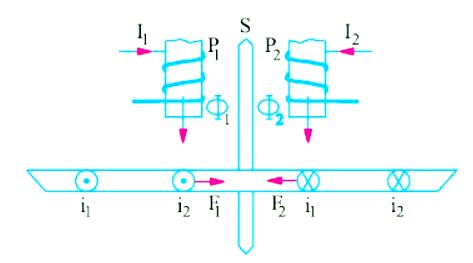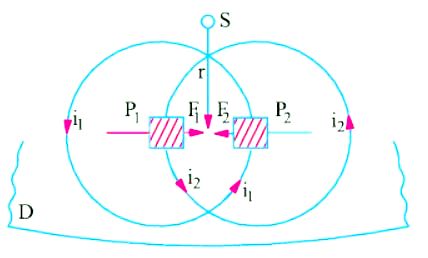Induction type Voltmeters and Ammeters
Induction type Voltmeters and Ammeters (instruments) are used only for A.C. measurements and can be used either as ammeter, voltmeter or wattmeter. However, the induction principle finds its widest application as a watt-hour or energy meter. In such instruments, the deflecting torque is produced due to the reaction between the flux of an A.C. magnet and the eddy currents induced by this flux. Before discussing the two types of most commonly-used induction instruments, we will first discuss the underlying principle of their operation.
Principle
The operation of all induction instruments depends on the production of torque due to the reaction between a flux Φ1 (whose magnitude depends on the current or voltage to be measured) and eddy currents induced in a metal disc or drum by another flux Φ2 (whose magnitude also depends on the current or voltage to be measured). Since the magnitude of eddy currents also depend on the flux producing them, the instantaneous value of torque is proportional to the square of current or voltage under measurement and the value of mean torque is proportional to the mean square value of this current or voltage.

Consider a thin aluminium or Cu disc D free to rotate about an axis passing through its centre as shown in Figure (A) & (B). Two A.C. magnetic poles P1 and P2 produce alternating fluxes Φ1 and Φ2 respectively which cut this disc. Consider any annular portion of the disc around P1 with center on the axis of P1. This portion will be linked by flux Φ1 and so an alternating e.m.f. e1 be induced in it. This e.m.f. will circulate an eddy current i1 which, as shown in Figure (A) & (B), will pass under P2. Similarly, Φ2 will induce an e.m.f. e2 which will further induce an eddy current i2 in an annular portion of the disc around P2. This eddy current i2 flows under pole P1.
Let us take the downward directions of fluxes as positive and further assume that at the instant under consideration, both Φ1 and Φ2 are increasing. By applying Lenz’s law, the directions of the induced currents i1 and i2 can be found and are as indicated in Figure (A) & (B).
The portion of the disc which is traversed by flux Φ1 and carries eddy current i2 experiences a force F1 along the direction as indicated. As F = Bil, force F1 ∝ Φ1 i2. Similarly, the portion of the disc lying in flux Φ2 and carrying eddy current i1 experiences a force F2 ∝ Φ2 i1.
∴ F1 ∝ Φ1i2 = K Φ1 i2 and F2 ∝ Φ2 i1 = K Φ2i1.
It is assumed that the constant K is the same in both cases due to the symmetrically positions of P1 and P2 with respect to the disc.
If r is the effective radius at which these forces act, the net instantaneous torque T acting on the disc begin equal to the difference of the two torques, is given by
T = r (K Φ1i2 − K Φ2i1) = K1 (Φ1i2 − Φ2i1) ……………………….(i)
AdBlock-2

Let the alternating flux Φ1 be given by Φ1 = Φ1m sin ωt. The flux Φ2 which is assumed to lag Φ1 by an angle α radian is given by Φ2 = Φ2m sin (ωt − α)
Induced e.m.f.

Assuming the eddy current path to be purely resistive and of value R, the value of eddy current is

It is obvious that
(i) If α = 0 i.e. if two fluxes are in phase, then net torque is zero. If on the other hand, α = 90°, the net torque is maximum for given values of Φ1m and Φ2m.
(ii) The net torque is in such a direction as to rotate the disc from the pole with leading flux towards the pole with lagging flux.
(iii) Since the expression for torque does not involve ‘t’, it is independent of time i.e. it has a steady value at all time.
(iv) The torque T is inversely proportional to R-the resistance of the eddy current path. Hence, for large torques, the disc material should have low resistivity. Usually, it is made of Cu or, more often, of aluminium.
Read article – Lenz’s law
Visit NCERTplanet.com for NCERT solutions and Textbook downloads




